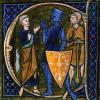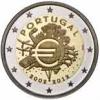Ed ecco il testo di Leo Mildenberg che già nel 1993 stimava che queste monete facessero parte di emissioni reali di Artaserse III (come le civette egizie e le altre emissioni carie).
In sostanza Mildenberg analizza l'iconografia di queste monete. Sul fatto che al R si veda un satrapo a cavallo mentre scaglia una lancia ha qualche dubbio; è vero che il personaggio indossa un copricapo tipico, ma non è sufficiente per farne un satrapo. Altri alti funzionari persiani indossavano tiare simili. Il personaggio al D, invece, è inequivocabilmente il Gran Re (o l'Eroe Reale), riprendendo l'iconografia dei sigloi e darici. La sua corona dentellata (kidaris) è molto enfatizzata. In più, su alcune monete (gruppo 5 secondo Konuk) troviamo la legenda greca BA, abbreviazione di ΒΑΣΙΛΕΩΣ. Questa è, per Mildenberg, la prova decisiva che determina l'appartenenza di tutte queste tetradracme alla monetazione regale di Artaserse III. Ciò che è coniato su queste monete non sono immagini autoctone né importate.
L'attribuzione di Babelon ad Evagoras II (361-351 aC) come satrapo in Asia Minore è basata solo sulla lettera ayin ("E") trovata su alcune monete (in particolare un darico unico custodito alla BNF), ma lo stesso Babelon ignora l'evidenza del titolo regale su altre monete (gruppo 5 secondo Konuk).
Mildenberg si chiede come sia mai stato possibile per un satrapo locale mostrarsi come il Gran Re con quella legenda particolare. Avrebbe un dignitario o un satrapo osato tanto ?
testo originale in inglese del 1997
The Great King-Horseman Issue
Another relevant and cohesive group of tetradrachms of Rhodian weight (Babelon, 1910: pl.91. 9-17), depicting on the obverse the Great King on foot drawing his bow and on the reverse a mounted “guard” wielding a spear (Mildenberg, 1993: nos. 116-123), is also a favored “proof” for the proponents of the “satrapal” coinage thesis. Admittedly, the horseman in question wears a type of Persian headgear commonly called a tiara, but this does not make him a satrap.
Other Persian officials wore the same cap. In contrast, the Great King’s portrayal is quite specific, recalling that on the daric and siglos ; his jagged crown is especially emphasized. Moreover, the abbreviated Greek legend BA for Baotlsbg (King) is decisive, as it was in the preceding group : this is the Great King, and the whole group is his coinage, What is shown on these coins is evidently neither an autochthonous image nor an imported one but the Great King himself. Babelon’s attribution of these coins to Evagoras ll, King ot`Sa1amis in Cyprus (361-351 B.C.) as a satrap in Asia Minor is based solely on the ayin (“E") found on some specimens (Babelon, 1910 : nos. 169-172), but it neglects the evidence of the regal title. One wonders why this view of the eminent scholar has still not been rectified ?
Would it have been possible for any local ruler to style himself as the Persian Great King in image and legend ? Would any Persian dignitary, satrap or not, dare to do so ? The Rhodian weight indicates a date well into the fourth century (IGCH 1216-1219). lt has recently emerged that the Great King-Horseman issue, known for a century, is larger than expected. Specimens now frequently appear indifferent auction sale catalogues. It has also come to light that the issue is more widespread and influential than had previously been supposed. Specimens have been discovered in the Carian “Pixodarus hoard" (see Hurter, 1998) and in the Syrian hoard (Price 1993 : no. 7). The coins were clearly known and popular in the Levant, since local fractions showing either the Great King or the horseman are represented in the Nablus hoard (IGCH 1504).


